The worst weeds have attributes that make them difficult for gardeners:
The weeds can be toxic to touch or eat. Have prickly thorns that cut your skin and snag clothing. Spread quickly and outcompete desirable plants. And are hard to get rid of once they become established.
Some of the worst offenders feature all of these nightmare ingredients.
So in this article, I’ll help you identify the worst weeds, so you can spot these unwanted plants early when they first appear in your garden and take action to deal with them in the best way.
Crabgrass (Digitaria sanguinalis)

Crabgrass is an invasive weed that looks similar to grass. Only, unlike the rest of your lawn, its coarse texture, thick blades, and lateral growth cause it to stand out and look unsightly.
It’s a common annual weed that germinates, grows, and dies within the space of a year. But what it does during that year can have long-term consequences for your lawn.
Crabgrass plants produce up to 150,000 seeds (1). And when they die, these seeds are left behind ready to germinate in spring the following year. Leading to a weed infestation.
Like many other types of garden weeds, if you leave crabgrass to grow it will crowd out and smother your lawn grass as it takes over.
And mowing won’t help you get rid of the problem, as they can set seed even when they’re only ½ inch tall. Which is lower than the recommended height for mowing lawn grass.
In order to control crabgrass, the best method is to prevent the seeds from germinating. So it’s a good idea to use a pre-emergent herbicide in early spring.
Post-emergent herbicides kill the crabgrass that’s already growing. But if they’ve already set seed, the problem will return next year.
You can also pull the plants out by hand. But depending on the size of the problem, this can be a lot of work.
Japanese Knotweed (Fallopia japonica)
Japanese knotweed is a noxious weed that causes serious problems if it grows on your property. Japanese knotweed is very hard to eradicate, and the plant spreads quickly through seeds, runners, and rhizomes.
This weed has thick, hollow, red stems that resemble bamboo. They grow in thick stands up to 15 ft. tall, crowding out and displacing native plants over a large area.
Shovel-shaped dark green leaves with pointed tips grow out from nodes on the stems. Flowering from August to September, Japanese knotweed produces branched clusters of small creamy-white flowers.
Controlling Japanese knotweed often requires professional help.
Giant Ragweed (Ambrosia trifida)
Giant ragweed is a noxious weed species native to North America. Giant ragweed is a tall weed that grows up to 12 feet, outcompeting other plants in the area by preventing them from receiving sunlight as it towers above them. Because of its size, giant ragweed can be very destructive to plant life when it moves into an area.
Giant ragweed has large lobed leaves that can measure 12-inches across. The weed has thick green or reddish stems that are rough and sometimes have a covering of fuzzy white hairs. The upper stem ends in a spike of yellow flowers that hang in clusters.
Giant ragweed spreads through seeds, producing spiky burs that catch on animal fur or clothing, or wash away with water. The weed is well-known for causing allergies, producing fine pollen that affects hayfever sufferers (2).
Pre-emergent herbicides can prevent giant ragweed seeds from developing. And multiple applications of post-emergent herbicides are often needed to kill existing plants.
Poison Sumac (Toxicodendron vernix)
Poison sumac is a perennial broadleaf shrub or small tree that most people consider a weed tree, as nobody wants this plant growing on their property.
The big problem with poison sumac is given away by the name: every part of the plant is toxic. Similar to poison ivy, poison sumac produces urushiol, an oil that causes an allergic response when it comes into contact with your skin. Urushiol is released by the plant whenever it’s crushed or bruised.
You can identify poison sumac by its red stems. Each stem has 7-13 smooth-edged leaves with sharp points growing in opposite pairs. When it blooms in June, the plant produces clusters of small yellow-green flowers, and eventually develops large clusters of green berries that hang from the stems and turn white in the fall.
It’s hard to control poison sumac because the weed can regrow from any part of the roots left in the soil. You can cut the plant down to the ground with pruning shears, but the plant will regrow, so you’ll have to repeat the job until the roots are exhausted and the plant dies.
Alternatively, you can cut the plant down to about 6-inches tall and apply systemic weed killer to the stump to kill the roots.
American Pokeweed (Phytolacca Americana)
American pokeweed is also called dragonberries, inkberry, and poke sallet. Pokeweed is a large perennial broadleaf weed. This invasive weed variety causes problems when it rapidly spreads into a new area, displacing native plants that struggle to develop in the shade of pokeweed’s bushy growth.
Pokeweed has very distinctive fruit. The weed produces large clusters of dark purple-red berries at the end of bright red stems. The red stems of the weed are also smooth, hairless, and partially hollow.
You’ll often see immature green berries and shiny ripe red berries in the same cluster. The berries are poisonous, so although they look juicy and appetizing make sure to leave them alone.
It’s easy to identify pokeweed by its fruit, but also look out for large, bright-green leaves that grow alternately. And before the berries develop, the plant produces clusters of small white flowers.
Because it’s difficult to remove the fleshy taproot from the soil, control of pokeweed usually involves herbicides.
Field Bindweed (Convolvulus arvensis)
Field Bindweed is sometimes called morning glory because it has similar-looking trumpet-shaped flowers that can be white, light pink, or sometimes both.
Field bindweed is a perennial broadleaf weed. This invasive vine weed is an aggressive grower that quickly develops slender stems up to 6 ft. long, climbing over trees, walls, fences, and along the ground.
The plant has smooth, arrowhead-shaped leaves connected to the stem by petioles. Mature leaves near the beginning of the stem are larger than the leaves at the end of the stem.
Field bindweed spreads by rhizomes, stems, and roots, and produces seeds that remain viable in the soil for 20 years or more. Once the vine weed becomes established, it’s very difficult to get rid of. And it quickly outcompetes plant species growing in the invaded area.
Field bindweed can be a major problem when it invades agricultural land as it can reduce yields by up to 60% (3).
The vine grows in a variety of conditions, in full shade and full sun, and is drought tolerant. You’ll often see field bindweed growing in farmland, forested parks, greenbelts, ravines, and gardens.
The most effective way to control field bindweed is the repeated use of systemic herbicides. If the weed grows on your lawn, you’ll need a selective weed killer.
Poison Ivy (Toxicodendron radicans)
Poison ivy is a noxious weed that grows as a groundcover, a shrub, or a climbing vine weed. Poison ivy is well-known for the uncomfortable rash that develops after you touch it, so be careful if you find this vine weed in your grass. The rash is caused by an oily resin called urushiol that’s present in the leaves, stems, and roots, so wear gloves when handling the plant.
You can identify poison ivy by its compound leaves consisting of 3 leaflets. The leaves grow alternately from a stem that’s sometimes tinged red. The leaves on young poison ivy plants are often reddish in the spring before turning shiny green. The leaves change to dull green in the summer and then turn yellow or scarlet in the fall.
Poison ivy is a perennial that loses its leaves in the winter, but the hairy vines remain. The weed regrows the leaves in the spring.
Poison ivy grows in various soil conditions, thriving in moist and very dry soil. And it grows in partial shade to full sun, sending out vines that can sometimes reach 100 ft. long.
You can control poison ivy with repeated cutting as it exhausts the root system, but it can take several years to kill the plant.
Common Mugwort (Artemisia vulgaris)
Mugwort is a sprawling perennial weed regarded as one of the worst weeds by the American nursery industry (4).
Its perennial and spreading growth habit facilitated by extensive rhizomes make it a troublesome pest in gardens, and it is considered to be one of the worst weeds by the American nursery industry.
West Virginia University Extension
The weed has elliptical leaves that grow alternately from the stem and can reach 1-2 inches long. The upper side of the leaves are smooth and dark green, and the underside is hairy and light green. The hairs are whitish and give leaf surfaces a silver appearance. When you crush the leaves, they give off a bittersweet aroma similar to sage.
Mugwort blooms between July and September and produces clusters of yellow-green flowers that lack petals. Following the flowers, small brown seeds develop that are dispersed by the wind.
Mugwort is a persistent weed that can be hard to control. The weed is able to tolerate low mowing heights and repeatedly bounces back after attempted removal. Repeated applications of chemical herbicides can sometimes work.
Once established in your garden, the weed spreads quickly through an extensive system of underground rhizomes, growing in dense stands that crowd out desirable plants. You’ll often notice mugwort growing in disturbed areas such as roadsides and park edges.
Deadly Nightshade (Atropa belladonna)
A list of the worst weeds would be incomplete without including deadly nightshade. Also known as belladonna, the plant is notorious for being a highly poisonous weed. All parts of the plant are toxic. Eating its sweet-tasting berries can be fatal, and even just handling deadly nightshade can make you ill from toxins that pass through the skin. If you’re lucky touching the plant will only lead to severe dermatitis.
Deadly nightshade is most easily identified by its purple bell-shaped flowers, that bloom from June to September. Like other weeds with flowers, the fruit quickly appears, with green berries at first before turning black and shiny, resembling cherries.
The weed has pale green, oval-shaped leaves that are pointed and ribbed. The leaves have smooth edges and grow alternately from the stem.
Deadly nightshade is often seen in woodlands, scrubland, and growing along paths and banks.
It’s possible to deadly nightshade by digging it out of the ground if you can remove all the roots. Otherwise, you can use chemical herbicides.
Kudzu (Pueraria montana)
Kudzu is an invasive weed that was introduced to the US from Asia. Its rapid spread has been devastating for the environment, with conditions allowing it to grow unchecked. And kudzu is now officially classified as a noxious weed.
Kudzu is a vine with large leaflets. Nodes along the vine propagate new stems allowing the plant to easily climb most structures. The nodes also root where they touch the soil, anchoring the weed in the ground. Kudzu prefers to grow in full sunlight. But this weed also thrives in the shade.
To control Kudzu, cut or mow the vine to the ground before treating the stumps with chemical herbicides. It sometimes takes multiple applications and several seasons to stop kudzu from regrowing.
Common Purslane (Portulaca oleracea)
If purslane is growing in your yard then you usually notice it either in late spring or early summer after the soil has warmed up.
Smooth, red stems grow close along the ground from a central taproot. And they often form a mat covering that stretches 2-3 feet from the root in varying directions.
Growing from the stems are flat, paddle-shaped leaves. With small flowers at the very tips that rapidly turn into seedpods containing brown/black seeds. After the seeds have matured, the pods burst open releasing their contents.
Purslane is a difficult yard weed to clear and often grows back again. It’s easiest to remove while it’s young. And you can pull it out of the ground by hand. Just make sure you don’t leave any of the roots behind.
If you wait until after it matures and disperses its seeds then you may find yourself having to deal with the problem long into the future. The seeds can survive in the soil for many years before being brought into the light and germinating. But a pre-emergent herbicide can help to stop them from sprouting.
Carolina Horsenettle (Solanum carolinense)
Also called devil’s tomato, horsenettle is part of the nightshade family. The weed produces fruit that resemble small tomatoes (5). But be warned, horsenettle is a poisonous weed and the fruit is toxic to eat. Just handling the plant causes a rash for some people.
Horsenettle emerges in the spring. And when fully grown, it reaches 3 ft. tall. Horsenettle weeds develop large thorns on the leaves and stems as the plant grows. The leaves are covered in hairs and have lobed margins. And they’re arranged alternately on the stems.
Horsenettle produces clusters of star-shaped flowers from May to October. Each flower consists of 5 white to pale-violet petals, with yellow anthers at the center.
It’s probably easiest to identify horsenettle by the tomato-like berries it produces. The berries are round and about ½-inch in diameter. And turn from green to yellow as they mature.
Frequent mowing can control horsenettle. Wait until the plant flowers before mowing the first time, as this is when the roots have used up a lot of their available energy.
Giant Hogweed (Heracleum mantegazzianum)
Giant hogweed is a perennial flowering shrub that originated in the western Caucasus region of Eurasia but has now spread around the world. First as an imported ornamental plant. And now as a noxious weed.
In the right conditions, the plant can grow 18 ft. tall. With a stiff tall stalk that grows up to 10 cm thick and 13 ft. high. When it blooms, you can see multiple clusters of white flowers growing from short stalks up into the air. They grow out from a central point, resembling an umbrella.
A fully grown plant has gigantic, deeply lobed leaves that can grow up to 5 ft. wide.
It’s sometimes mistaken for similar-looking plants such as cow parsnip, woodland angelica, purple stem angelica, lovage, valerian, and Queen Anne’s lace.
But giant hogweed grows much taller than any of these. And the stalk has reddish-purple spots and coarse bristles. None of the lookalikes have both of these.
You should wash your hands immediately if you touch hogweed. The watery sap is phototoxic and can cause serious burns if you expose your skin to sunlight (6).
When giant hogweed sap, which contains photosensitizing furanocoumarins, contacts human skin in conjunction with sunlight, it can cause phytophotodermatitis – a serious skin inflammation.
Department Of Environmental Conservation
If you only have a small number of weeds to deal with, you can cut the main taproot 3-4 inches beneath the soil in early spring. You may need to repeat in the summer if the plant regrows.
When dealing with large infestations, you can use post-emergent herbicides, most effective during the summer when the plant is rapidly growing.
Canada Thistle (Cirsium arvense)
Canada thistle is a perennial broadleaf weed. Thistles are thorny weeds that are a prickly nuisance wherever they appear.
Thistles grow from seeds dispersed by the wind. And you can accidentally introduce them to your yard in topsoil and mulch.
Thistles typically grow between 2-5 ft. tall. And each thistle plant develops a large root system that can grow 20 ft. long in a single season.
Even a small piece of root in the soil can regrow a new plant. Which makes thistles tricky to get rid of. To control the spread you can cut off the unopened buds to prevent the plant from flowering and seeding. And you can use herbicides to kill the weed.
Creeping Charlie (Glechoma hederacea)
A common nuisance in gardens, if you’ve got a purple-flowered weed growing in your lawn then there’s a good chance that this is the culprit.
Also called ground ivy, creeping charlie is a common broadleaf weed that can quickly take over your yard if you leave it.
It grows low to the ground, usually about 1 inch high, and quickly forms a dense mat of leaves and stems as it spreads.
Other distinguishing features that can help you identify it include a square stem and bright green leaves with scalloped edges, either kidney-shaped or round.
Leaves grow in opposite pairs on either side of the stem attached to a node. And you can see the blueish purple flowers along the stem when it blooms in spring.
It’s important to know that creeping charlie finds it easiest to colonize lawns that aren’t well cared for. So to keep it away it’s a good idea to regularly mow, fertilize, and water your lawn to help it grow thick and strong. Leaving no room for weeds to become established.
The weed spreads by runners, rhizomes, and seeds. And it can be difficult to get rid of. Because even after you dig creeping charlie out of the soil, leaving any part of the rhizomes behind allows the plant to regrow.
If you catch small patches of the plant early in the spring, then it can be worth having a go at hand pulling it. But this often takes a number of attempts to completely eradicate the plant.
The easiest way to get rid of this unwanted plant is to use a post-emergent weed killer that can tackle broadleaf weeds.
But make sure the product specifies its use for creeping charlie because not all broadleaf weed killers can do the job.
It’s also important to choose a systemic weed killer. These are absorbed by the plant and kill it from the inside including the roots.
And if you’re using it on grass, make sure it’s selective for broadleaf weeds so it won’t cause harm.
Jimson Weed (Datura stramonium)
Jimson weed is an invasive weed that’s a member of the nightshade family. It’s also known as thorn apple and devil’s snare.
Jimson weed produces a large fruit encased in a spiky capsule. But be careful not to eat it. Jimson weed is a notorious poisonous weed that’s dangerous when ingested. And just touching the plant can cause rashes.
Jimson weed is a big weed that grows up to 6.5 ft. tall. The plant has green stems that are sometimes purple-tinged. And alternating leaves with toothed edges.
The plant blooms in summer. With trumpet-shaped violet or white flowers up until the first frost.
Regular mowing can control jimson weed, but it might take a number of seasons to wear the plant out. Chemical herbicides are most effective when you apply them to young plants.
Quackgrass (Elymus repens)
QUACKGRASS BY MATT LAVIN FROM BOZEMAN, MONTANA, USA, CC BY-SA 2.0
Also known as common couch, this invasive weed spreads quickly due to prolific underground rhizome growth. It’s one of the most aggressive weeds that grow in lawns.
But it also reproduces from seeds, which disperse through the air and germinate in thin lawns further away.
It’s easy to identify:
Firstly, it’s a tall grass that quickly develops large patches.
And secondly, the leaves are broader than most lawn grasses and feel rough when you run your fingers across them.
Because quackgrass is a common lawn weed, having a thick and healthy lawn is a good first defense to stop it from becoming established and taking over.
If you see it growing in your garden you can try to dig it out. But it can be difficult. The roots break easily. And you have to make sure you don’t leave them behind or the weed will grow back.
You can get rid of quackgrass using weed killer. But most selective weed killers don’t work. And using a non-selective weed killer will also damage your lawn unless you’re very careful.
Goat Head Weed (Tribulus terrestris)
Goat head weed is also called devil’s thorn, puncturevine, and bindii. It’s notorious for the sharp barbs on its fruit. These vertical spikes resemble horns, and easily puncture thin shoes, bare feet, bicycle tires, and the hooves of animals. This allows the seeds to be carried to new locations (7). And so the plant spreads.
Goat head weed is a creeping weed that grows low to the ground. With long hairy stems that grow up to 5 ft. long. Forming a dense mat as they spread out from a central taproot.
Goat head weed is a fast-growing noxious weed. It germinates in the spring and starts flowering within 3 weeks. Producing yellow flowers from April through to October. After the flowers bloom, the weed produces the small spiky fruit.
You can control goat head weed by hand pulling or using a hoe to cut the weed away from the taproot. It’s best to deal with goat head weed before it flowers and produces seeds.
Nutsedge (Cyperus rotundus)

YELLOW NUTSEDGE WEED BY HOMER EDWARD PRICE, CC BY 2.0
Before it blooms, nutsedge resembles tall grass. But there are some distinctive differences when you look closely
To start with, nutsedges are V-shaped. And they’re usually thicker and stiffer. With leaves in a set of 3, rather than the set of 2 commonly seen on grass.
Yellow nutsedge produces golden-yellow flowers and seeds. With purple nutsedge producing red-brown flowers when they bloom, and dark brown or black seeds.
It’s a perennial weed that spreads by seed, underground rhizomes, bulbs, and tubers. With each tuber having the capacity to create hundreds of shoots in a 3-6 ft. area. As well as forming 100+ new tubers.
This makes nutsedge one of the worst weeds to control. The key is to stop nutsedge from establishing itself, as once it does, it’s difficult to get rid of.
Make sure you remove young plants before they’ve had a chance to develop the tubers.
If you find mature nutsedge plants already established in your garden, then pulling them out is unlikely to work. If you leave the rhizomes and tubers behind they will continue to sprout.
Instead, get a herbicide that targets nutsedge and can kill everything above and below the ground.
A more organic strategy is to grow a dense lawn that can crowd it out. Preventing it from being able to successfully root.
Nutsedge often thrives in waterlogged soil. So eliminating the wet conditions that help it to grow is a good idea.
Mile-A-Minute (Persicaria perfoliata)
PERSICARIA PERFOLIATA BY KATJA SCHULZ
Mile-a-minute is also called Asiatic tearthumb, giant climbing tearthumb, and devil’s tail. Originally from East Asia and India, mile-a-minute was introduced to North America in the 19th century and is now an invasive plant and noxious vine weed in many states. The plant is an herbaceous annual vine that dies each fall and regrows each year from seeds that germinate in the spring.
True to its name, mile-a-minute grows fast, adding an extra 6-inches of growth a day at its peak until reaching its full size, usually somewhere from 20-30 ft. The vines intertwine to form a dense blanket.
The green to reddish-colored stems are prickly with sharp thorns, so be careful when handling this viney weed. Light green, triangular leaves grow alternately from the stem. Small white flowers grow in special cup-shaped leaves growing at intervals from the vine stems. The flowers eventually give way to blue berries that start off green.
Mile-a-minute thrives in full sunlight, and the thorns on its stems help the vine clamber over other plants and man-made obstacles to reach a brighter location. The plant also likes a high soil moisture content and often colonizes wetlands, streambanks, forest edges, and roadsides.
Pre-emergent herbicides can prevent mile-a-minute seeds from developing, and plants can be pulled or cut back repeatedly to kill the vine weed.
References:
- Biology And Management Of Crabgrass – https://ag.umass.edu/turf/fact-sheets/biology-management-of-crabgrass
- 7 Things You May Not Know About Ragweed Pollen Allergy – https://community.aafa.org/blog/6-things-you-may-not-know-about-ragweed-pollen-allergy
- Field Bindweed – https://www.nwcb.wa.gov/pdfs/Bindweed_factsheet_King.pdf
- Mugwort – https://extension.wvu.edu/lawn-gardening-pests/weeds/mugwort
- Horse Nettle – https://mdc.mo.gov/discover-nature/field-guide/horse-nettle
- Health Hazards & Safety Instructions for Giant Hogweed – https://www.dec.ny.gov/animals/72556.html
- Puncturevine – https://www.nwcb.wa.gov/weeds/puncturevine
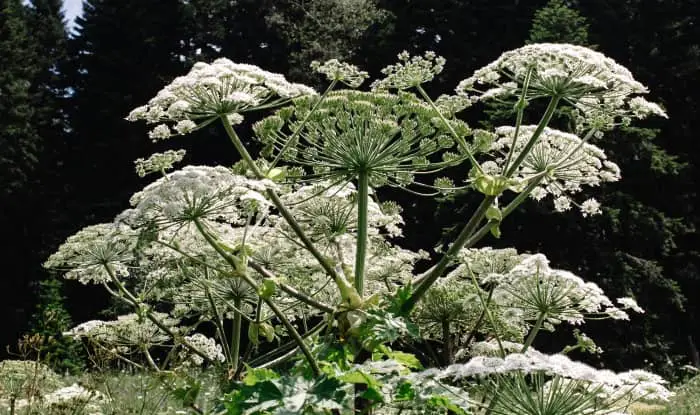
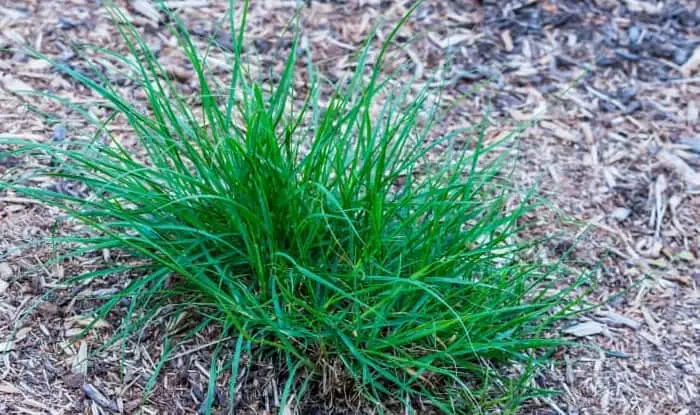
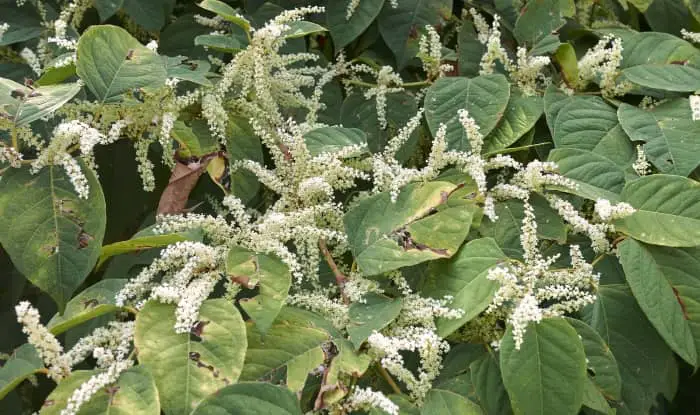
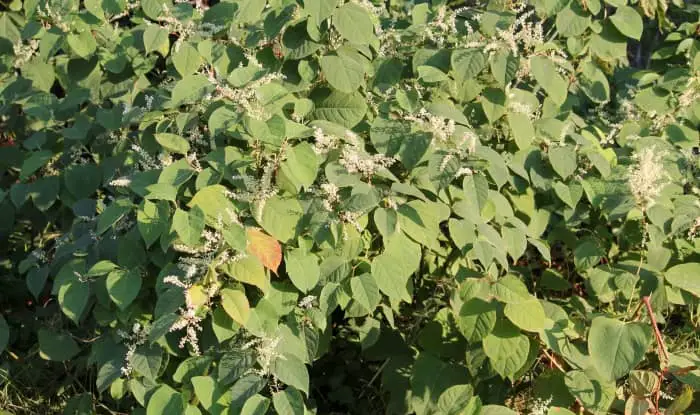
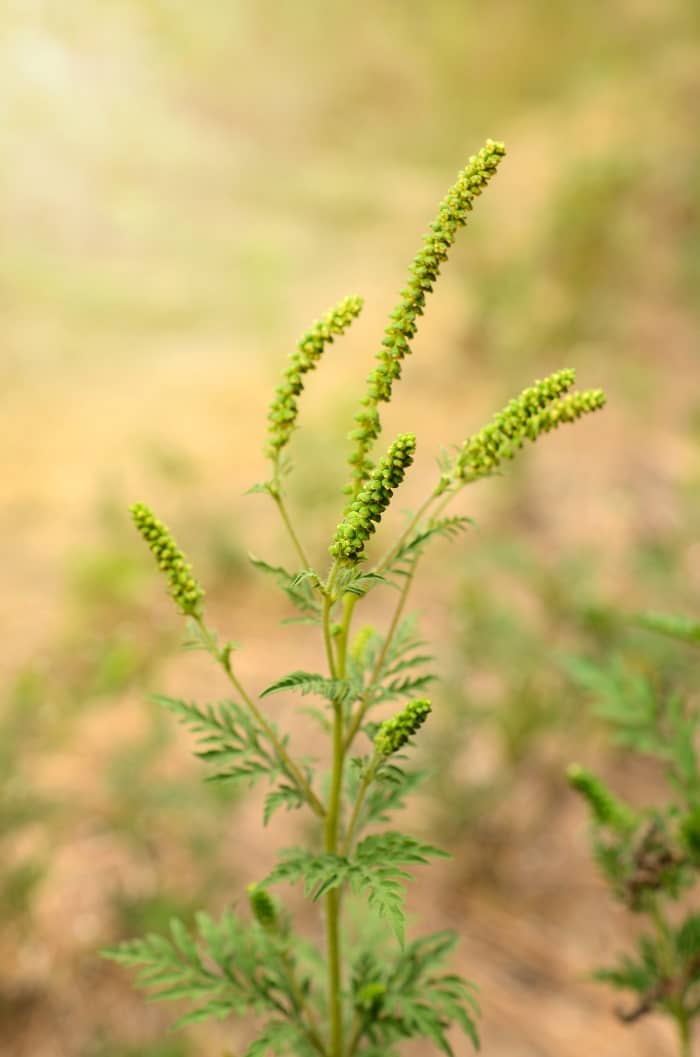

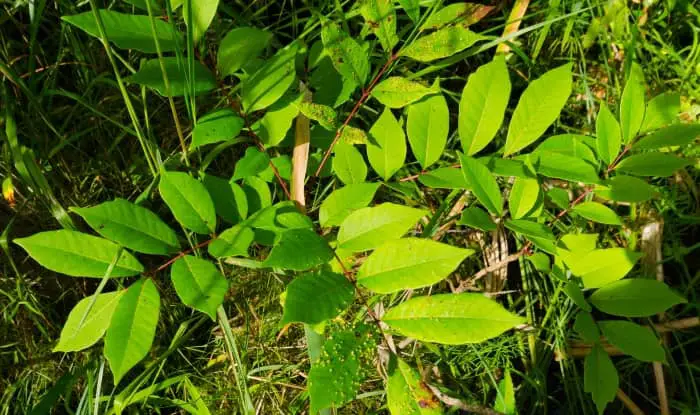
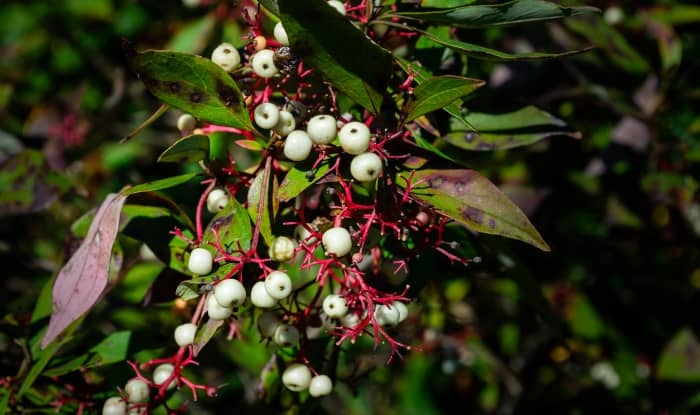
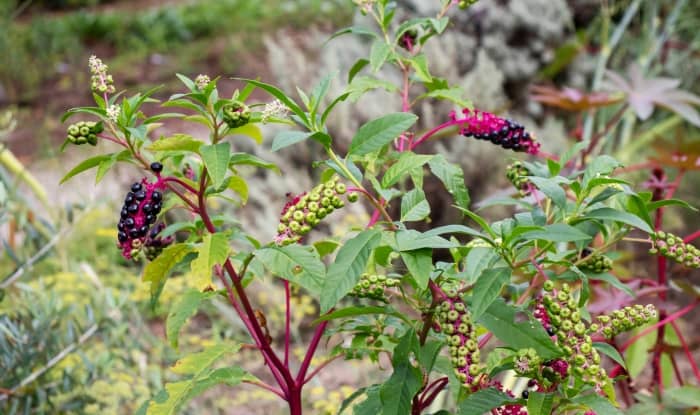

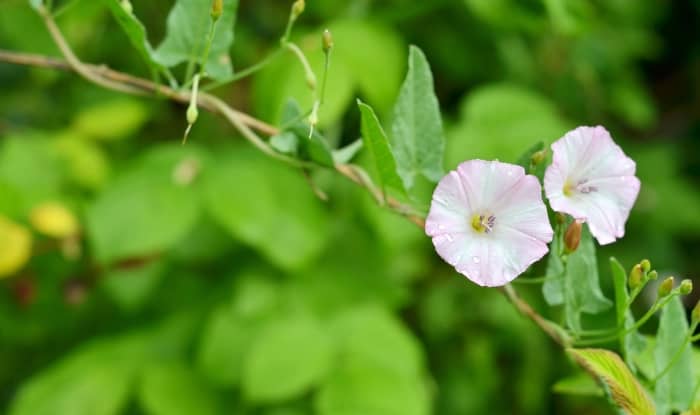
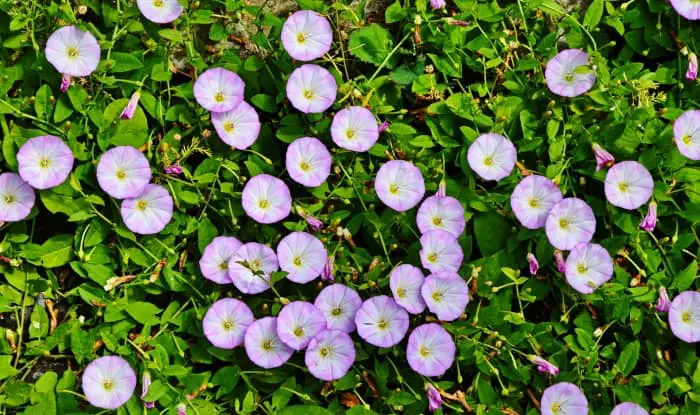
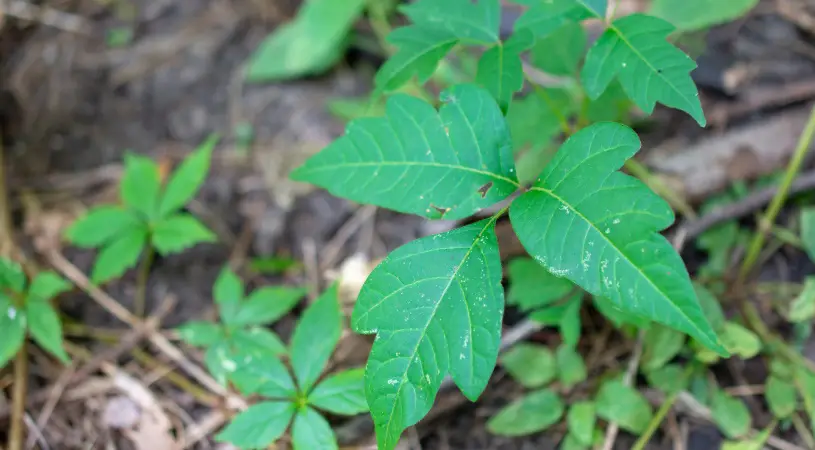
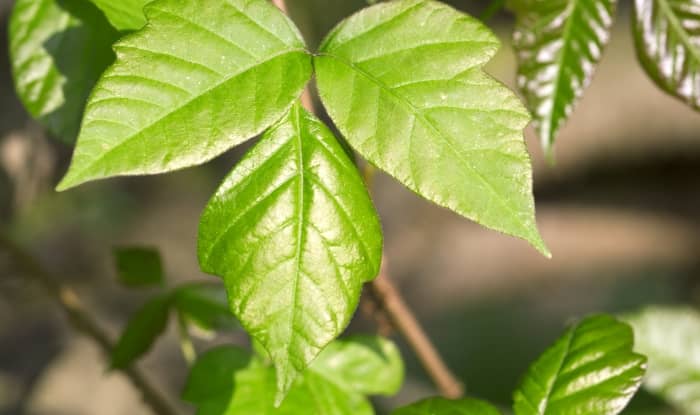

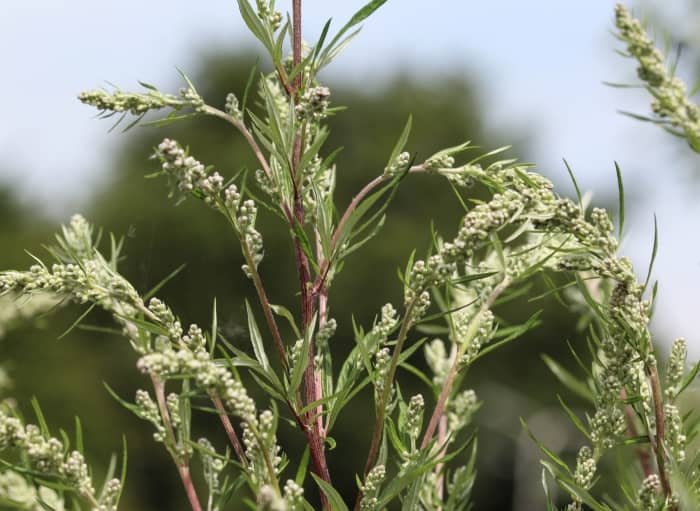
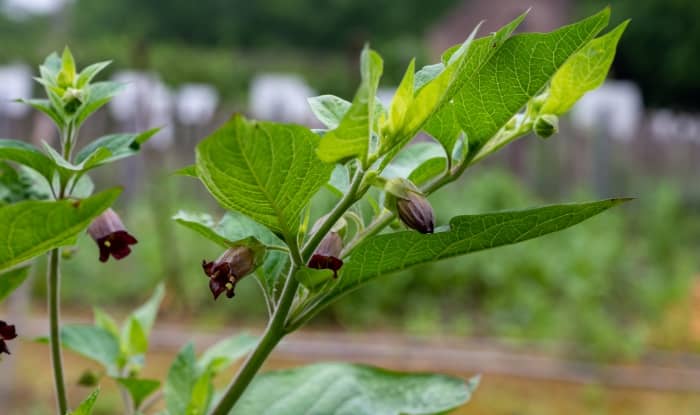
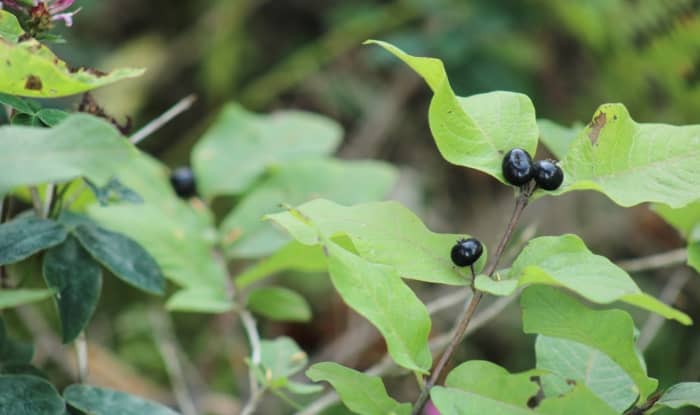
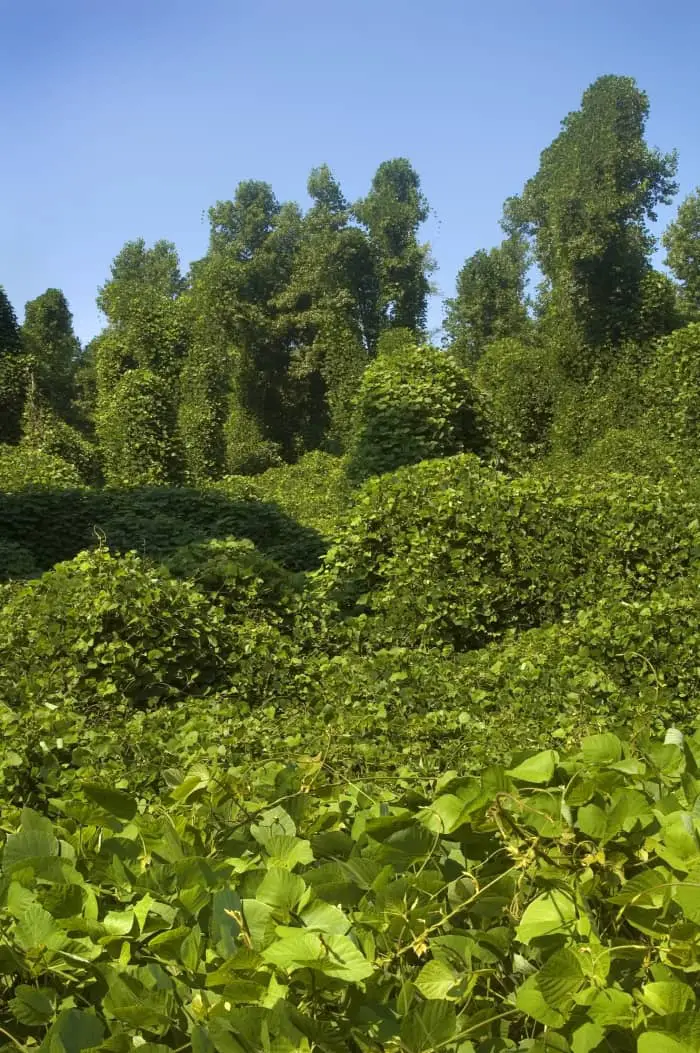
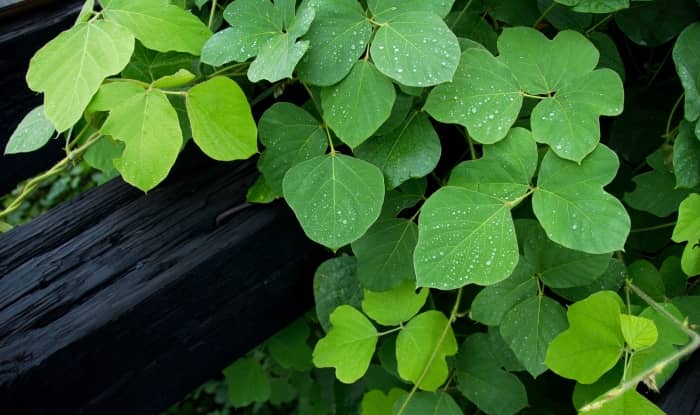
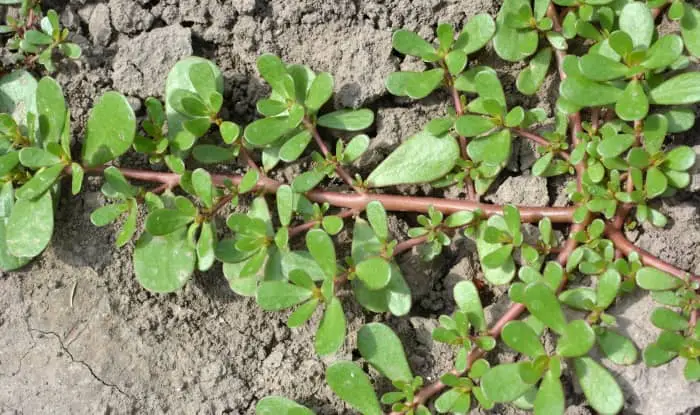
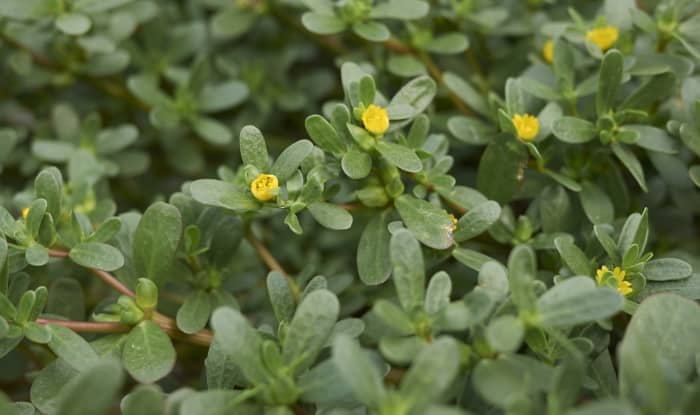
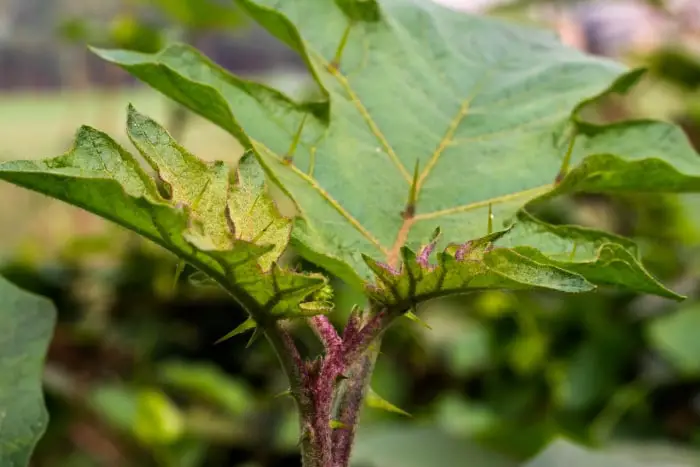
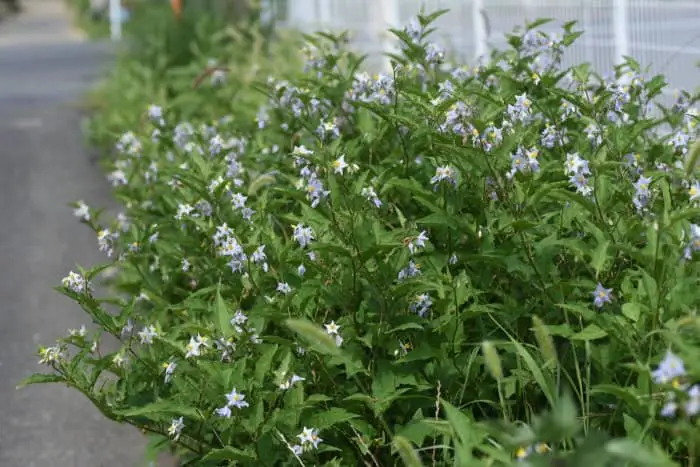
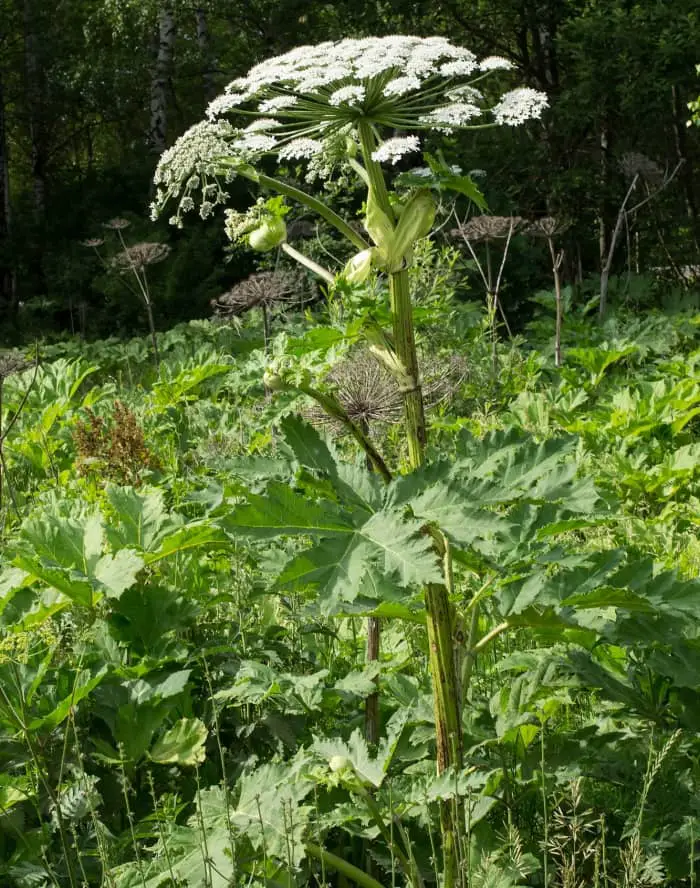
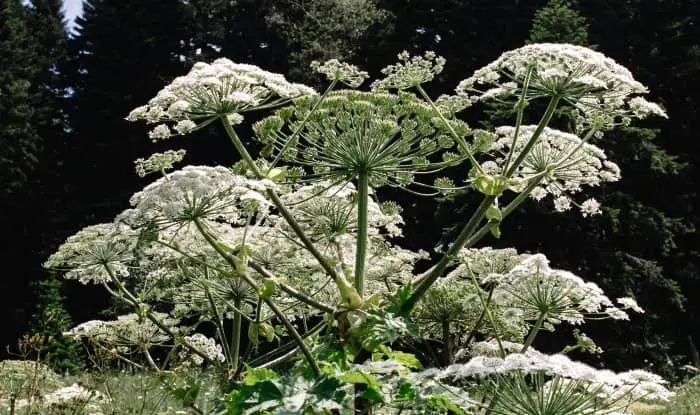
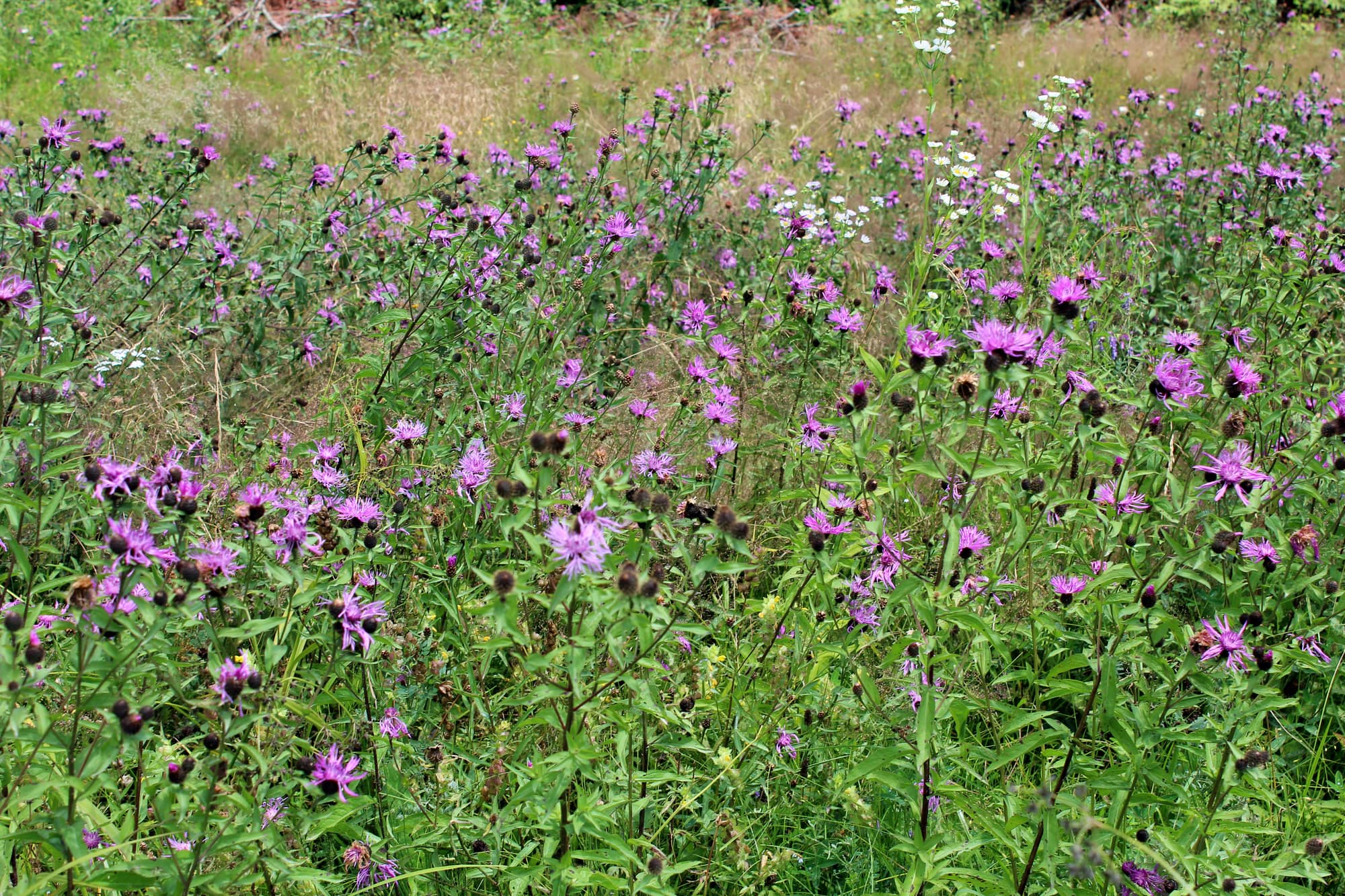

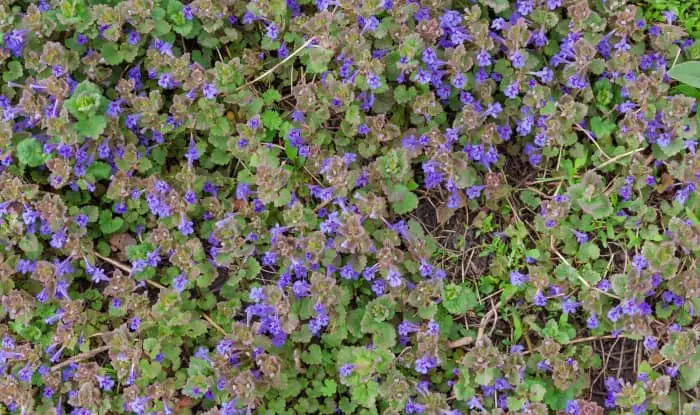
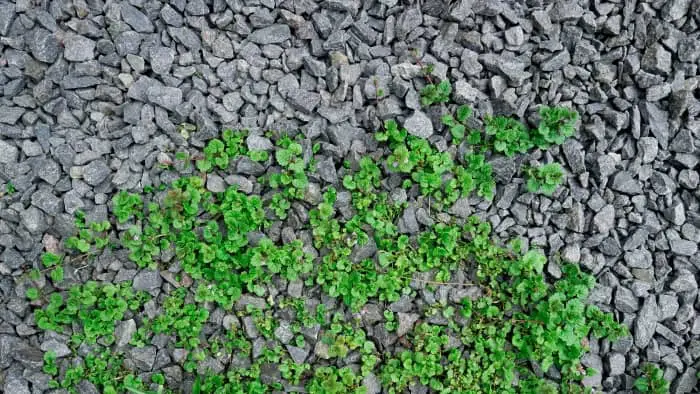


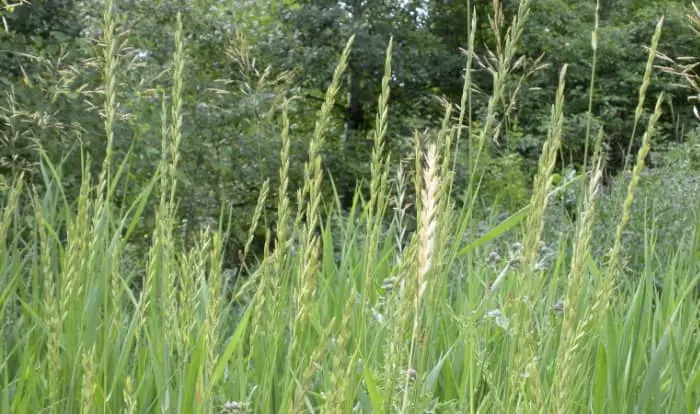

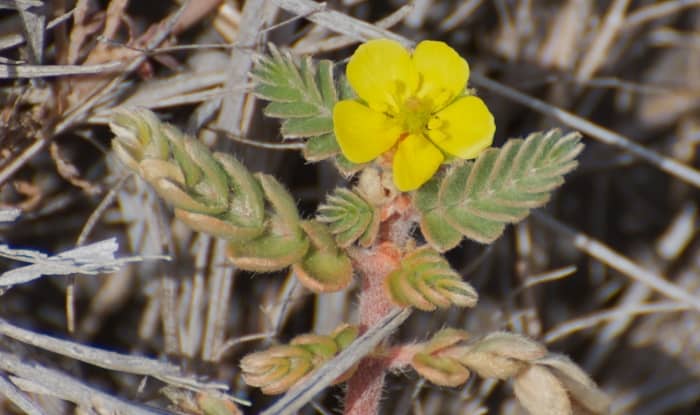
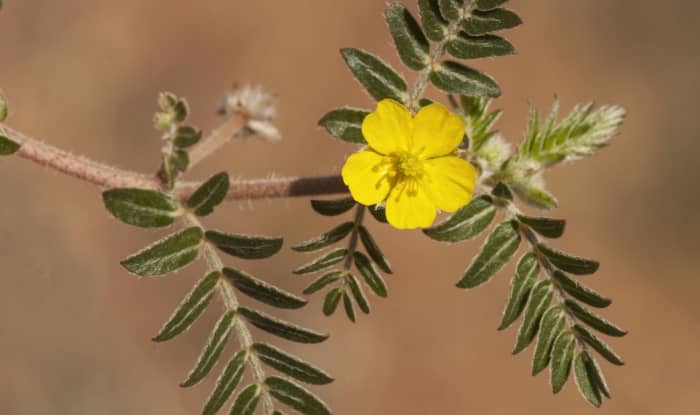

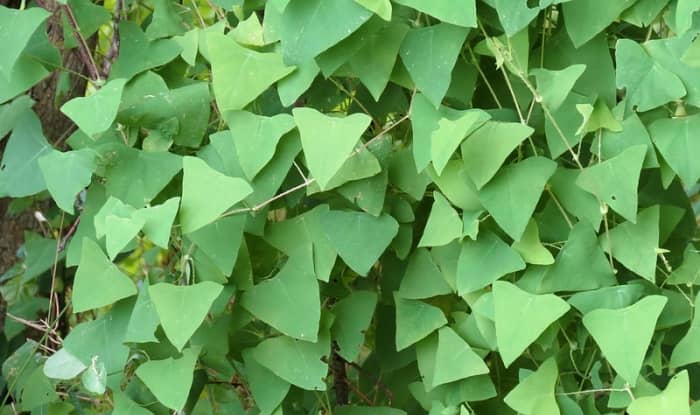
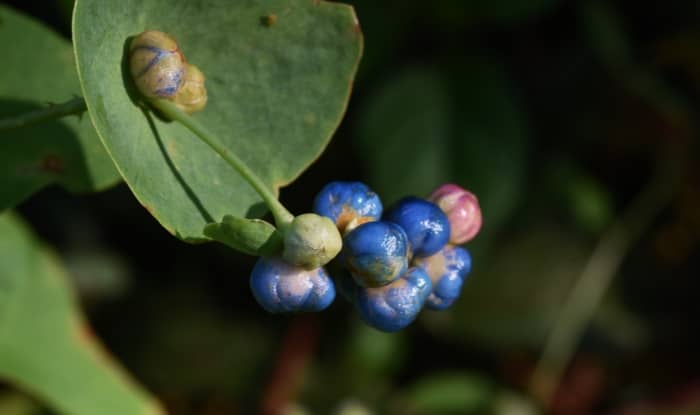

I don’t see bell flower on your list, it uis destoying my peonie beds, seems unstopable, HELP??